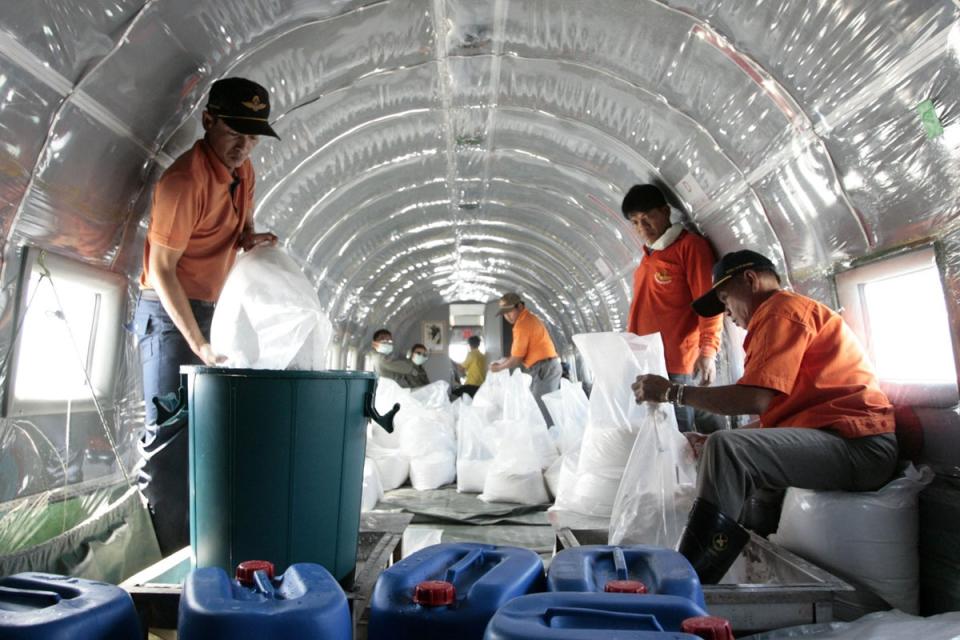What is cloud seeding? Dubai's freak weather linked to artificial rain

The United Arab Emirates (UAE) has been hit by what the government described as the heaviest rainfall in the past 75 years.
The torrential downpours began on Monday night, and by Tuesday evening the desert city of Dubai had received the average amount of rainfall it normally gets for the whole year.
This caused traffic to grind to a standstill, flight cancellations, and school closures.
The UAE government warned citizens to stay inside and leave only "in cases of extreme necessity”.
Bloomberg reported that cloud seeding led to heavy rains that caused catastrophic flooding throughout the arid nation.
One of the UAE’s main newspapers, The National, rejected claims that cloud seeding was responsible for the three-day downpour across the UAE. However, it said it could have played a minor role.
Even though plenty of places have inadequate drainage, the UAE has been conducting seeding operations since 2002 to address water security concerns.
Ahmed Habib, a meteorologist, told Bloomberg that Gulf state's National Centre of Meteorology sent out seeding planes from Al Ain airport on Monday and Tuesday to capitalise on convective cloud formations.
Many videos of the carnage caused by the heavy rain have been circulated on social media. In one, footage showed cars being washed off roads.
One X (formerly Twitter) user said: “Dubai is a crazy place.”
Dubai is a crazy place pic.twitter.com/qu5w41qvYX
— Cleared Improve (@ClearedImprove) April 17, 2024
Sharing the chaos at Dubai Airport, another user said: “Current situation of Dubai Airport”
Current situation of Dubai Airport pic.twitter.com/rh8wCxEKkj
— Dr Honey choudhary (DOCTORS SQUAD ) (@Doctors__squad) April 17, 2024
The flooding also affected animals. One X user shared a post showing Dubai police rescue officers rescuing a cat.
Dubai police rescue a stranded cat after record rain and massive flooding in UAE pic.twitter.com/Dps0uJUUem
— War Intel (@warintel4u) April 17, 2024
So what is cloud seeding and why is it controversial?
What is cloud seeding?
Cloud seeding is a weather modification technique where substances are dispersed into the air to encourage cloud condensation or ice crystal formation, thereby inducing precipitation. This process is typically employed to enhance rainfall or snowfall in areas experiencing water scarcity or drought conditions.
Cloud seeding was first conducted in 1946 by American chemist Vincent Schaefer. Working with atmospheric scientist Irving Langmuir, Schaefer conducted experiments to artificially induce snowfall by seeding clouds with dry ice (solid carbon dioxide). This groundbreaking experiment happened in the Berkshire Mountains of Massachusetts, United States.
Schaefer's successful cloud-seeding experiment marked the beginning of modern cloud-seeding techniques and sparked interest in the potential of weather modification to enhance precipitation. Since then, cloud seeding has been studied and implemented in various parts of the world to increase rainfall, reduce hail damage, and mitigate drought conditions.

The UAE uses cloud seeding to increase rainfall, especially during the dry season. Due to its arid climate, the UAE faces challenges in water availability, and cloud seeding offers a potential solution to augment precipitation levels. The country has actively invested in cloud-seeding technology and research to mitigate water scarcity.
Cloud seeding has also been used in various other countries, including:
China: China has one of the most extensive cloud seeding programmes globally. It's been used to alleviate droughts, clear pollution from the air, and ensure favourable weather conditions, particularly during events such as the Beijing Olympics.
United States: Cloud seeding is practised in several states, including California, Texas, and Colorado, to increase water supply in reservoirs and enhance snowpack in mountainous regions.
Australia: Cloud seeding has been used in Australia to increase rainfall in regions experiencing drought or water shortages, particularly in agricultural areas.
Thailand: Thailand has implemented cloud seeding to address water scarcity issues and support agriculture.
Russia: Cloud seeding has been utilized in Russia to increase precipitation and manage weather conditions, especially in regions prone to drought.
Why is cloud seeding controversial?
Cloud seeding is a contentious topic due to concerns about its environmental impact, effectiveness, and ethical implications.
Critics worry about the unintended consequences of introducing foreign substances into the atmosphere, potentially affecting air quality and ecosystems.
There are debates about whether cloud seeding disrupts natural weather patterns and whether its benefits outweigh the risks.
Legal and political issues, such as water rights and regulation, further complicate the matter. Despite its potential to address water scarcity, public perception of cloud seeding remains sceptical, highlighting the need for transparent research and careful consideration of its implications.

 Yahoo Sport
Yahoo Sport 





































